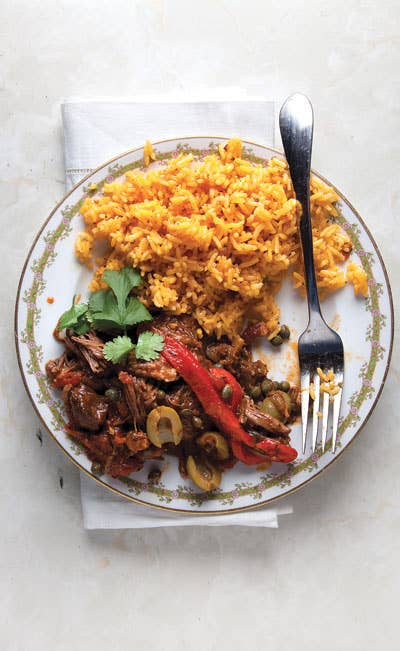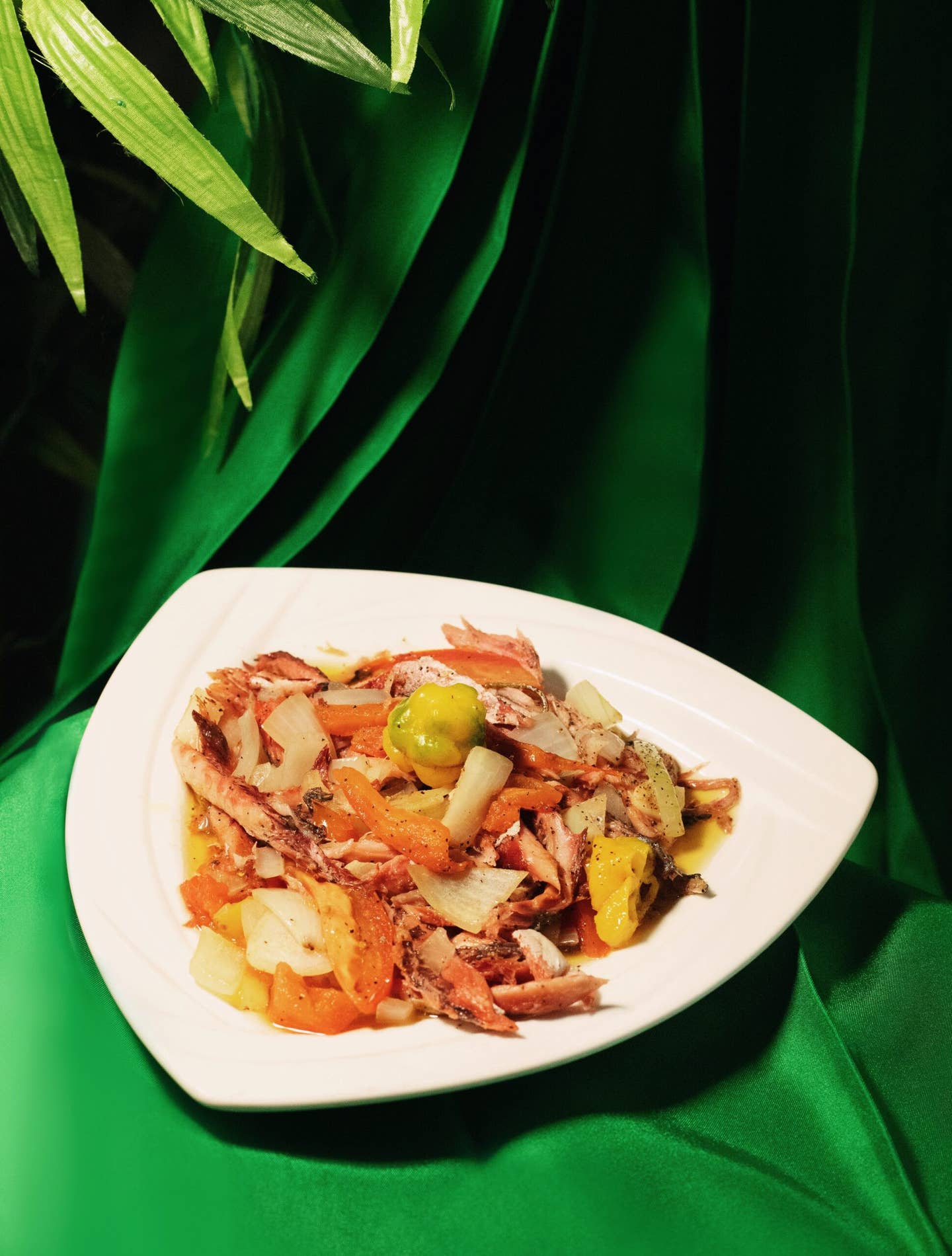
Spanish Conquest
The name immediately caught my interest: ropa vieja. Translation: "old clothes." We were at a Cuban restaurant in Miami many years ago, and my husband, who's from Puerto Rico, explained that it was a delicious beef stew he knew from back home. If it's so delicious, I wondered, why would it have such an unappetizing name?
When my plate arrived, I felt the label was even more unjust. The dish consisted of shredded beef, stewed with onion and peppers, as tender as can be with a long-cooked tangy tomato flavor. Olives and capers added a subtle salinity, and the whole was flecked with fresh and dried herbs and served with a big pile of fluffy rice, tinted yellow with annatto. After that meal it became my go-to Cuban dish, until I realized it wasn't Cuban at all.
This realization happened on a recent trip to the Canary Islands, located west of Morocco but belonging to Spain since the 1400s. We were exploring Mercado de Nuestra Señora de Africa, a peach-colored Spanish colonial structure full of produce vendors in the port city of Santa Cruz de Tenerife. When we bellied up to the bar at one of the market's food stalls, El Chiringuito, I was shocked to find my favorite Cuban stew on the menu. I asked our server why they served this Cuban specialty, and she wagged her finger at me and smiled.
"We created this dish, not the Cubans," the woman said, firmly. When my ropa vieja arrived, it was meaty, soft, and tangy, but there were marked differences from the dish I knew. It contained shredded pork and chicken, as well as beef, with a generous lacing of plump chickpeas. Instead of the rice accompaniment I was accustomed to, the stew was ladled atop fried potato cubes. I loved the seasoned, succulent meat as much as I did in the Cuban version, but I had so many questions: How did the dish come to be? How did it get to Cuba? And why was it called "old clothes"?
To find the answers, I paid a visit to Cesar Gonzalez, a native of Tenerife and executive chef at El Mirador at the Abama hotel. He laughed as he told me the local folklore surrounding the dish's roots. "There was once a man so poor, he couldn't afford to feed his children," he said. "He became so desperate that he cooked old clothes as if they were meat. He gave so much love in the process that it magically turned into a delicious stew." (Everyone I queried recounted a similar story.)
Gonzalez serves two versions: One is his grandmother's recipe—a bright, sweet, peppery, colorful concoction—and the other is a modernized riff, where the chickpeas are manipulated into a hummuslike puree and the shredded meat is served in dainty portions.
Ropa vieja is still very much a household staple in the Canary Islands, and you can find it in marketplaces, take-out counters of grocery stores, working-class restaurants, and especially at guachinches, casual eateries in the local wineries that serve traditional food. I learned that the dish was created as a way to take advantage of the leftovers from making puchero, the islands' classic vegetable soup. Puchero was traditionally made in the morning, and by lunch, the meat used to flavor the stock would be falling into shreds. Cooks would strain it from the soup and saute it with frituar, the aromatic base made with onions, peppers, garlic, tomato paste, and seasonings that's known as sofrito in much of the Latin world. Chickpeas from the soup were added to the meat, and that hearty mixture was served atop fried potatoes.
Although the dish is made with new-world ingredients such as tomatoes, potatoes, and peppers, Canarian food writer Manuel Iglesias told me that the cooking style stretches back to the Romans. "Their recipes always started with a giant pot of stew," he said. "Then the ingredients in the stew were used in different ways."
But what interested me even more than the ancient predecessors of ropa vieja was how it crossed the Atlantic, and what happened next. The dish likely migrated to Cuba, along with tens of thousands of Canarians, in the 19th century. The earliest-known documentation of ropa vieja's presence there appeared in an 1857 cookbook, Nuevo Manual del Cocinero Cubano y Español, where the recipe is curiously cited as "American-style," likely for its lack of potatoes and chickpeas. The dropping of potatoes made sense; rice was Cuba's most common starch. But no one can account for how the chickpeas became lost at sea, since they were already a staple of Cuban cuisine. Perhaps it was an early show of independence from Spain?
When Cuban culture came to the States, the "old clothes" came too. Nowadays it's a staple at restaurants in Miami—from Versailles, the 41-year-old political hub of Cuban expats, to the not-so-coincidentally named Islas Canarias (around half a million people of Canarian descent currently call Miami home). It pervades Latino cookbooks, from Nitza Villapol's 1954 Cuban culinary bible, Cocina Criolla, to a Crock-Pot version in actress Eva Longoria's Eva's Kitchen (Clarkson Potter, 2011). In Cuba, though, you'd be hard-pressed to find ropa vieja in homes today, since beef is tightly restricted by the government. "No one—no one!--can slaughter cattle. It must be turned over to the state," a Cuba-based diplomat told me. But the Cuban dish has spread across the Caribbean, from Puerto Rico to Venezuela (where it's known as pabellon) to Panama.
Like so many dishes rooted in resourcefulness, this one is so beloved that cooks have figured out ways to make it even if they don't have leftovers on hand or time to make stock from scratch. When I make the Cuban version, I sear the beef, and then put it in a slow cooker with water, tomatoes, peppers, and onions. The result is just as delicious, and as comforting as wearing some of my favorite old clothes.
Keep Reading
Continue to Next Story










